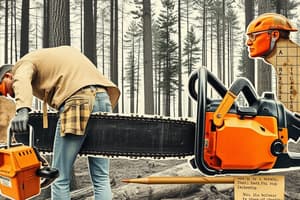Podcast
Questions and Answers
What is the main purpose of using hard hats in a workplace?
What is the main purpose of using hard hats in a workplace?
- To protect against head injuries from falling objects. (correct)
- To provide visibility in low light conditions.
- To improve communication among workers.
- To shield against harsh weather conditions.
Which technique is essential for safe manual lifting?
Which technique is essential for safe manual lifting?
- Bending at the knees and keeping the back straight. (correct)
- Keeping the load far from the body.
- Twisting the body while lifting.
- Using only the back to lift heavy objects.
How should hazards be reported according to safety protocols?
How should hazards be reported according to safety protocols?
- Write them down at the end of the day.
- Discuss with coworkers for consensus.
- Report identified hazards to a supervisor immediately. (correct)
- Ignore minor hazards if they seem unimportant.
What is a crucial step in developing emergency response plans?
What is a crucial step in developing emergency response plans?
What should be done regularly to ensure the effectiveness of personal protective equipment (PPE)?
What should be done regularly to ensure the effectiveness of personal protective equipment (PPE)?
What practice is recommended for proper tool maintenance?
What practice is recommended for proper tool maintenance?
Which of the following is an example of a physical hazard that should be identified?
Which of the following is an example of a physical hazard that should be identified?
What is a best practice for securing loads when using material handling techniques?
What is a best practice for securing loads when using material handling techniques?
Flashcards are hidden until you start studying
Study Notes
Personal Protective Equipment (PPE)
-
Types of PPE:
- Hard hats: Protect against head injuries from falling objects.
- Safety glasses: Shield eyes from debris and chemicals.
- Ear protection: Prevent hearing loss from loud machinery.
- Respirators: Filter harmful dusts, fumes, and vapors.
- Gloves: Protect hands from cuts, chemicals, and temperature extremes.
- Steel-toed boots: Provide foot protection against heavy objects.
-
Proper Use:
- Ensure PPE fits correctly and is comfortable.
- Inspect PPE regularly for damage or wear.
- Replace any damaged or expired equipment immediately.
Safe Handling Techniques
-
Manual Lifting:
- Bend at the knees and keep back straight.
- Use legs to lift, not the back.
- Keep the load close to the body.
- Avoid twisting while lifting.
-
Material Handling:
- Use appropriate lifting devices (e.g., forklifts, hoists).
- Secure loads properly before moving.
- Maintain clear pathways free of obstructions.
Hazard Identification
-
Recognizing Hazards:
- Conduct regular site inspections for potential hazards.
- Identify physical (e.g., moving machinery) and environmental (e.g., wet surfaces) hazards.
- Assess chemical risks (e.g., exposure to toxic substances).
-
Reporting and Mitigation:
- Report identified hazards to a supervisor immediately.
- Implement control measures (e.g., barriers, signage, training).
Emergency Procedures
-
Developing Plans:
- Create clear emergency response plans for different scenarios (e.g., fire, injury).
- Designate assembly points and evacuation routes.
-
Training:
- Conduct regular drills to practice emergency procedures.
- Ensure all workers are familiar with emergency contacts and procedures.
Tool Maintenance
-
Regular Inspections:
- Inspect tools before each use for defects or damage.
- Look for loose parts, frayed cords, or rust.
-
Cleaning and Storage:
- Clean tools after use to prevent rust and buildup.
- Store tools in designated areas, away from moisture and direct sunlight.
-
Repair and Replacement:
- Schedule regular maintenance checks.
- Replace tools that cannot be safely repaired.
Personal Protective Equipment (PPE)
- Types of PPE include hard hats for head protection, safety glasses to shield eyes, ear protection to prevent hearing loss, respirators that filter harmful substances, gloves for hand safety, and steel-toed boots for foot protection.
- Proper fitting and comfort of PPE are crucial for effective protection; regular inspection for damage or wear is necessary.
- Immediate replacement of any damaged or expired PPE is essential for maintaining safety standards.
Safe Handling Techniques
- Manual lifting techniques advise bending at the knees and keeping a straight back to avoid injury; lifting should be done using leg strength, keeping loads close to the body, and avoiding twisting motions.
- For material handling, appropriate lifting devices like forklifts should be used, ensuring loads are secured before movement, and maintaining clear pathways free from obstructions.
Hazard Identification
- Regular site inspections help in recognizing physical (e.g., moving machinery) and environmental hazards (e.g., wet surfaces) as well as assessing chemical risks from toxic exposures.
- Identified hazards should be reported to a supervisor without delay, and control measures such as barriers, signage, and training must be implemented to mitigate risks.
Emergency Procedures
- Clear emergency response plans must be developed for various scenarios, including fires and injuries, along with designated assembly points and evacuation routes.
- Regular drills are essential to ensure preparedness for emergencies, and all workers should be familiar with emergency contacts and procedures.
Tool Maintenance
- Regular inspections of tools before use are critical to identify defects or damages, checking for loose parts, frayed cords, or rust.
- Tools need to be cleaned after use to prevent rust buildup and should be stored in designated areas, protected from moisture and direct sunlight.
- Scheduling regular maintenance checks is necessary, and tools that cannot be safely repaired should be replaced immediately.
Studying That Suits You
Use AI to generate personalized quizzes and flashcards to suit your learning preferences.




